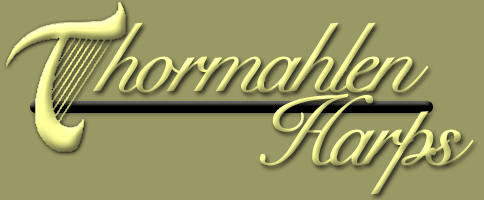by Carolyn Deal
"On my deathbed I looked back at my life and
had no regrets for things I had done, but I did have regrets for
things I had not done." LIFE IS SHORT. BUY A HARP.
What an opportunity, to be able to try so many harps
to find the one that fits your dream! These are items that will
be important to you over the years, adding to your enjoyment:
1. Sound, tone of harp. Soft enough, or projecting
enough, for where you'll use it.
2. Feel of the harp. Is it comfortable to reach
the bass strings, the high strings, and how does it feel on your
shoulder? You aren't supposed to bear much weight on your shoulder;
the harp should be almost at its balance point and then tipped
back just slightly onto your right knee and shoulder, but it will
still be a comfort factor. Sit at proper height to judge this;
all harps are more comfortable if you sit correctly.
3. String tension. Some like it light. Some like
it tight. Try them all and see what feels best to you and gives
you the sound you desire. Light tension is great for Irish ornamentation
or if you have hand problems. Firmer tension is great for dynamics
and will develop strength in your hands. Ask harp makers and other
harpers their thoughts. Feel for yourself.
4. String spacing. You commonly hear "standard
spacing" but actually there is not a folk harp "standard."
Small hands need closer. Large hands can handle larger spacing.
Large spacing means it's easier to not buzz the string you just
plucked ---easier not to hit it when you replace your fingers
on the next string, especially in the bass. But spacing that is
too large for your hands, strains you to do octaves in the bass,
or to reach a 10th in the bass. Advanced players may want closer
spacing for quicker maneuvering in Irish dance music. Or not!
TRY different harps and see for yourself.
5. Appearance. So many gorgeous harps!!! Gotta
have three?
6. Weight. A heavier harp can have an impactful
sound, and you can always use a harp dolly to move it. Pedal harpists
move their harps! And if you want to grab a harp and go, check
out the many medium weight or light harps that have "Wow" sounds
today. Harp cases usually have shoulder straps.
7. Size. Do you want it to fit in a certain size
car? A car trunk? Or do you want a large harp that will make an
impressive sight at a wedding? As for a therapy or travel-size harp,
does it need to go on an airplane?
8. Number of strings. For a full harp, go two octaves
below middle C if you can afford it. This allows you to play all
the music out there! A few harps have extra strings below that for
added drama and fun. But down to that C is standard. Up from there,
34 or 36 strings makes a "full" sized folk harp. But lots
of other sizes are a blast, too. 29 strings, harps that end on a
low G, and other configurations… all of these may fit your
size needs. More strings in general means more choice.
9. Small harps! Lap harps and therapy harps and
"camping trip" harps… Everyone should have one
in addition to a full harp!! Go sit by a stream, play at a friend's
bedside after surgery, practice on a trip; play in bed! It's a
nice break from the biggie, less complicated, and the smaller
number of strings helps you learn music principles. When
the low string is an octave below mid C, that gives you the most
flexibility, but a cool lap harp down to F or G is a blast too.
Playing a harp in nature is an experience not to be missed. Gift
yourself.
10. Ease of tuning. Can you turn the pins smoothly
and fine-tune each string? Or does the pin "ratchet" forward,
making it difficult? Since you have to tune and fine-tune your harp
often, it should be a joy. How well does it stay in tune: Ask other
owners of the harp.
11. Sharping levers. Try them. Do they flip in
a way you like? Do they change the tone of the string very much?
(Some will mute the string more than others). To save money, you
can buy a harp with just C and F levers and play in C, G, and D
keys. Or add B levers and you can also play in key of F. And G levers
are fun for some Scandinavian and other music. And… Full levers,
if you can afford them, give you the most flexibility. Of course
your camping trip harp may not need to be fully levered.
12. Price. It's a lifetime investment. It's not
hard to sell a used harp on the Celtic Harp Page (internet). Buy
the best harp you can afford. It will draw you to play every day
and add so much sparkle to your life! And your harp skills
will grow in leaps and bounds with a harp that you love.
13. Durability and guarantee. If you follow basic
care guidelines, you may never have any challenges, but it's nice
to know that the harpmaker or company stands behind their work.
We at Thormahlen Harps want you to have the harp of
your dreams. So do your research and we hope that you come to us
for that harp.
Back to models page or on
to the  endorsements
page.
endorsements
page.
